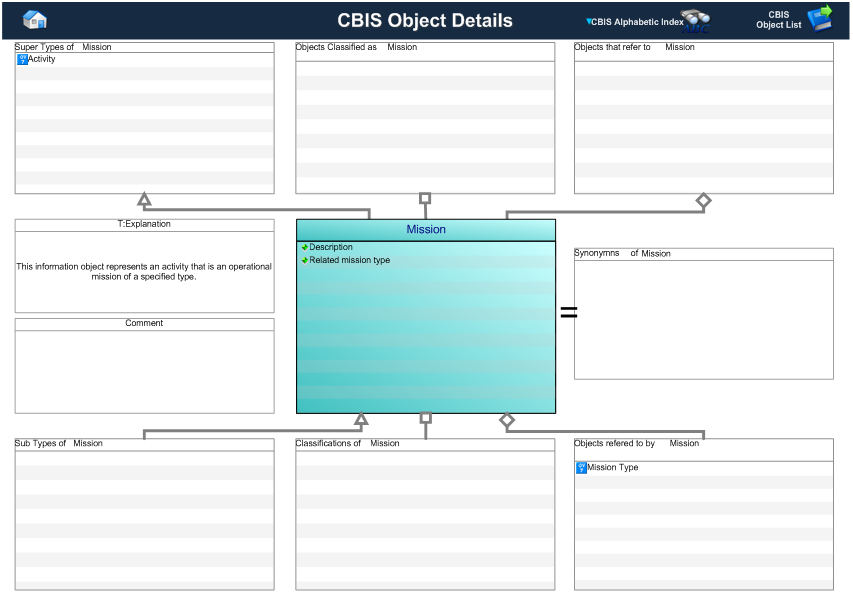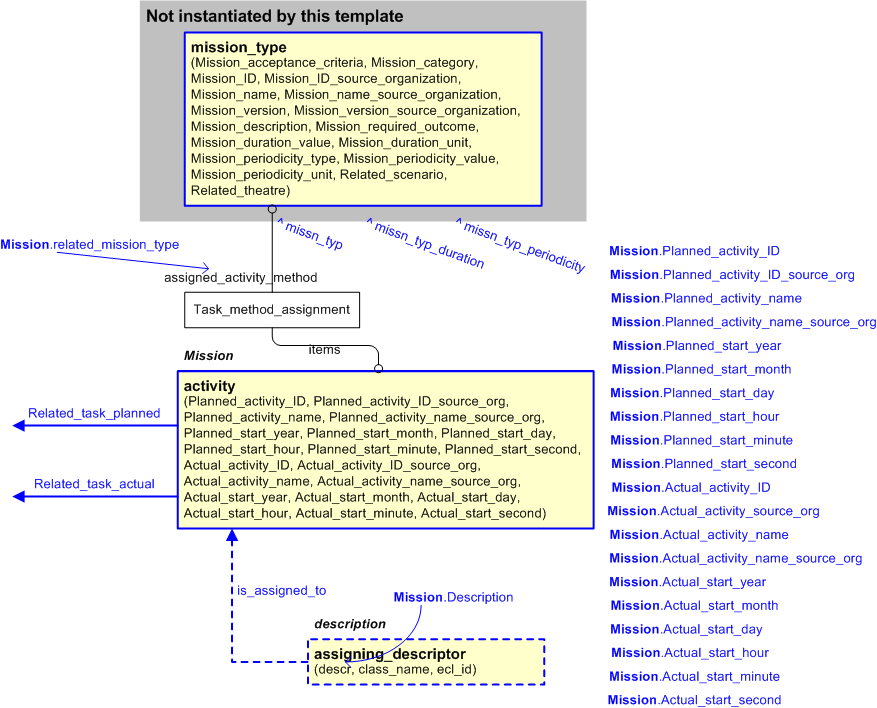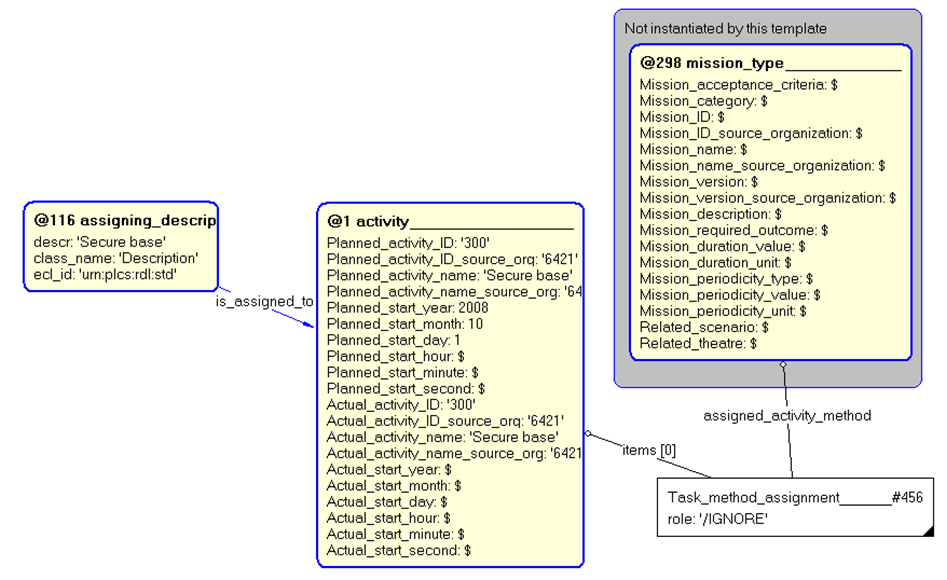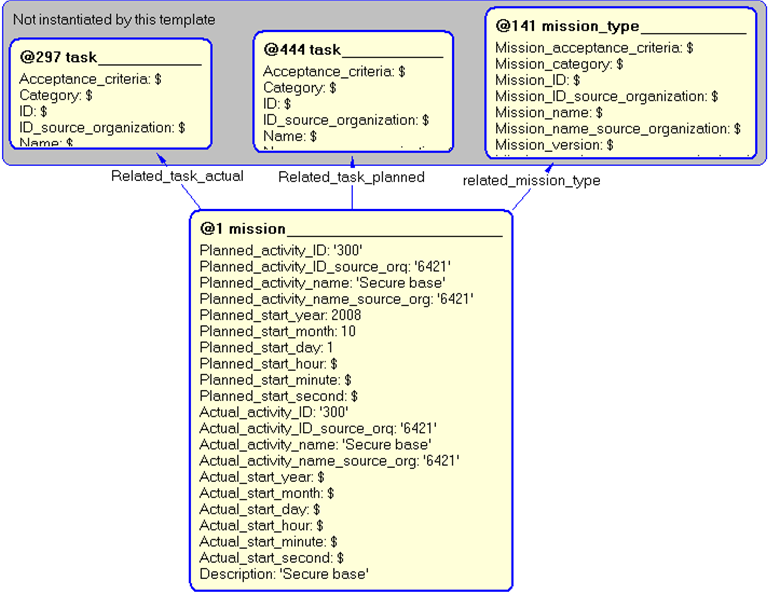Template:— mission (missn)
Context:— UK_Defence |
Date: 2009/10/30 11:29:57
Revision: 1.2
|
This section specifies the template mission.
NOTE
The template has been defined in the context of
UK_Defence.
Refer to the business context for details of related templates.
NOTE
An explanation of a template and the associated instantiation path is
provided in the
Template overview
section.
This template describes how to represent the UK_Defence concept of a mission
in terms of PLCS model elements (templates, entities, and reference data)
This is data about a specific objective to be achieved within laid down parameters.
This is data about a specific objective to be achieved within laid down parameters.
Figure 1 — Graphical Representation for Business Object Mission
The attributes of the Mission object are tabled below. (note - this object inherits attributes from UK_Defence.activity in addition to those shown below)
|
Attribute name
|
Attribute description
|
Attribute type
|
Optionality
|
| Description |
This is the description of the mission. |
intrinsic |
Optional |
| Related Mission Typr |
This is the reference to the mission type of which this mission is one instance. |
Mission Type |
Mandatory |
Table 1 — Mission attribute details
The EXPRESS-G diagram in
Figure
2
shows the templates and EXPRESS entities that are required
to represent the template
"mission".
The text highlighted in blue shows the template parameters.
Figure 2 — An EXPRESS-G representation of the Information model for mission
The graphic for the template to be used in other EXPRESS-G diagrams
is shown in Figure
3
below.
Figure 3 — The graphical representation of the mission template
The following input parameters are defined for this template:
The identifier of the planned activity.
The identifier of the organization that is the source of the identifier of the planned activity.
The name of the planned activity.
The identifier of the organization that is the source of the name.
The year component of the date and time the activity is planned to start.
The month component of the date and time the activity is planned to start.
The day component of the date and time the activity is planned to start.
The hour component of the date and time the activity is planned to start.
The minute component of the date and time the activity is planned to start.
This parameter is optional. If not given, it will remain unset.
The second component of the date and time the activity activity is planned to start.
This parameter is optional. If not given, it will remain unset.
The task that defines the planned activity.
The identifier of the actual activity.
The identifier of the organization that is the source of the identifier.
The name of the actual activity.
The identifier of the organization that is the source of the name.
The year component of the date and time the activity was started.
The month component of the date and time the activity was started.
The day component of the date and time the activity was started.
The hour component of the date and time the activity was started.
The minute component of the date and time the activity was started.
This parameter is optional. If not given, it will remain unset.
The second component of the date and time the activity was completed.
This parameter is optional. If not given, it will remain unset.
The task that defines the actual activity.
The description of the mission.
This is the reference to the mission type of which this mission is one instance.
The following reference parameters are defined for this template:
Allow the
Activity_actual
entity instantiated in this path to be referenced when this template is used.
%^target = $mission.activity%
Allows referencing of entity Activity_actual from outside the template, e.g.
in order to characterize the Activity_actual further.
The following parameter combinations specify a uniqueness constraint:
Unique constraint: mission_type
The instantiation path shown below specifies the entities that are to be
instantiated by the template.
A description of templates and the syntax for the instantiation path is
provided in the
Templates Help/Information section.
/
activity(
Planned_activity_ID=@Planned_activity_ID,
Planned_activity_ID_source_org=@Planned_activity_ID_source_org,
Planned_activity_name=@Planned_activity_name,
Planned_activity_name_source_org=@Planned_activity_name_source_org,
Planned_start_year=@Planned_start_year,
Planned_start_month=@Planned_start_month,
Planned_start_day=@Planned_start_day,
Planned_start_hour=@Planned_start_hour,
Planned_start_minute=@Planned_start_minute,
Planned_start_second=@Planned_start_second,
Related_task_planned=@Related_task_planned,
Actual_activity_ID=@Actual_activity_ID,
Actual_activity_ID_source_org=@Actual_activity_ID_source_org,
Actual_activity_name=@Actual_activity_name,
Actual_activity_name_source_org=@Actual_activity_name_source_org,
Actual_start_year=@Actual_start_year,
Actual_start_month=@Actual_start_month,
Actual_start_day=@Actual_start_day,
Actual_start_hour=@Actual_start_hour,
Actual_start_minute=@Actual_start_minute,
Actual_start_second=@Actual_start_second,
Related_task_actual=@Related_task_actual)/
-- Assign reference parameters %^activity = $activity.activity_actual%
-- description /
assigning_descriptor(
descr=@Description,
class_name='Mission_description',
ecl_id='urn:plcs:rdl:uk_defence',
is_assigned_to=^activity)/
-- Related_mission_type Task_method_assignmentTask_method_assignment.assigned_activity_method ->
@related_mission_typeTask_method_assignment.items ->
^activity
The instance diagram in Figure
4
shows an example of the EXPRESS entities and templates that are instantiated by the template:
/mission(Planned_activity_ID='300', Planned_activity_ID_source_org='6421', Planned_activity_name='Secure base', Planned_activity_name_source_org='6421', Planned_start_year='2008', Planned_start_month='10', Planned_start_day='1', Planned_start_hour='', Planned_start_minute='', Planned_start_second='', Related_task_planned='', Actual_activity_ID='300', Actual_activity_ID_source_org='6421', Actual_activity_name='Secure base', Actual_activity_name_source_org='6421', Actual_start_year='', Actual_start_month='', Actual_start_day='', Actual_start_hour='', Actual_start_minute='', Actual_start_second='', Related_task_actual='', Description='Secure base', related_mission_type='@298', Related_task_planned='@444', Related_task_actual='@297')/
(an illustration of the consolidated mission template is shown in
Figure
5 below.)
Figure 4 — Entities instantiated by mission template
The instance diagram in
Figure
5
shows the graphic symbol for the template that is to be
used in other instance diagrams. The example template is:
/mission(Planned_activity_ID='300', Planned_activity_ID_source_org='6421', Planned_activity_name='Secure base', Planned_activity_name_source_org='6421', Planned_start_year='2008', Planned_start_month='10', Planned_start_day='1', Planned_start_hour='', Planned_start_minute='', Planned_start_second='', Related_task_planned='', Actual_activity_ID='300', Actual_activity_ID_source_org='6421', Actual_activity_name='Secure base', Actual_activity_name_source_org='6421', Actual_start_year='', Actual_start_month='', Actual_start_day='', Actual_start_hour='', Actual_start_minute='', Actual_start_second='', Related_task_actual='', Description='Secure base', related_mission_type='@298', Related_task_planned='@444', Related_task_actual='@297')/
Figure 5 — Instantiation of mission template
Characterizations
No common characterizations of the template
mission
have been identified. However, the ISO 10303-239 EXPRESS model
may enable other assignments to the entities instantiated by the template.




